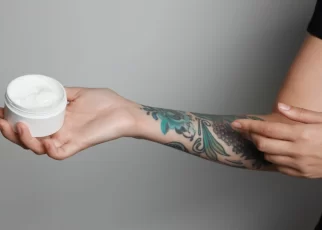Tattoo Healing Stages – Getting a tattoo is an exciting and personal experience, but it’s equally important to understand the following healing process. From the moment the tattoo artist puts down their needle, your body begins a remarkable journey of rejuvenation and restoration. This blog will delve into the various stages of tattoo healing, sharing valuable insights, tips, and precautions to ensure your new ink heals beautifully and stands the test of time. So, whether you’re a first-timer or a seasoned tattoo enthusiast, join us as we unravel the fascinating world of tattoo healing stages and help you confidently navigate each stage.
Tattoo Healing Stages
Tattoo healing can be divided into stages, each with specific changes and requirements. Understanding these stages of tattoo healing will help you properly care for your tattoo and ensure optimal recovery. Here are the various tattoo healing stages:
- Fresh Tattoo: Immediately after getting a tattoo, your skin will be sensitive, red, and possibly swollen. The tattooed area may also ooze a combination of blood, ink, and plasma. Following your tattoo artist’s aftercare instructions is crucial during this stage. It typically involves gently washing the tattoo, applying a thin layer of ointment, and keeping it clean and protected.
- Scabbing and Peeling: As the tattoo begins to heal, it may develop scabs or a thin, flaky layer of skin. It’s essential to resist the urge to pick or scratch these scabs, as it can cause colour loss or scarring. Allow the scabs to naturally fall off, and avoid exposing the tattoo to excessive moisture during this stage.
- Itching and Dryness: The tattooed area may start to itch as the healing progresses. This is a normal part of the healing process, but it’s important to resist scratching or rubbing the tattoo, as it can disrupt the healing skin and introduce bacteria. Applying a fragrance-free moisturizer your tattoo artist recommends can help alleviate dryness and reduce itching.
- Settling and Fading: Over a few weeks, your tattoo will gradually settle into your skin. The colours may appear slightly muted or hazy during this stage, but don’t worry—this is temporary. The tattoo will regain its vibrancy as the healing continues.
- Fully Healed: The final stage of tattoo healing is when the tattoo is fully healed and settled in your skin. The colours will appear bright and the lines crisp. It’s important to note that healing times can vary for each person, depending on factors such as tattoo size, location, and individual healing ability.
Throughout the healing stages, it’s crucial to maintain proper aftercare, which typically includes keeping the tattoo clean, avoiding prolonged exposure to sunlight, refraining from swimming or soaking the tattoo in water, and wearing loose clothing to prevent irritation. By following these guidelines, you can ensure your tattoo heals beautifully and maintains its longevity and vibrancy for years to come.
Tattoo Aftercare Practices
Proper aftercare is essential for ensuring your tattoo heals successfully. Here are some important tattoo healing aftercare tips to follow:
- Follow your tattoo artist’s instructions: Your tattoo artist is the best source of aftercare information specific to your tattoo. They will provide you with detailed instructions on how to care for your tattoo during the healing process. Follow their guidance closely and ask any questions you may have.
- Keep it clean: Gently wash your tattooed area with warm water and mild, fragrance-free soap. Use your hand or a soft cloth to cleanse the tattooed skin carefully. Avoid using harsh scrubbing motions or rubbing the area forcefully.
- Apply a thin layer of ointment: After cleaning your tattoo, apply a thin layer of tattoo aftercare ointment or a recommended moisturizer. Be sure to use only products your tattoo artist recommends, as some lotions or creams may contain ingredients that can irritate or damage the tattoo.
- Avoid excessive moisture: While it’s important to keep your tattoo clean, avoid excessive exposure to water, especially in the early stages of healing. Avoid swimming, or soaking in bathtubs, or hot tubs, as these activities can introduce bacteria to the healing skin and prolong the healing process.
- Protect it from the sun: UV rays can fade and damage your tattoo, especially during healing. Keep your tattoo covered or apply sunscreen with a high SPF to protect it from the sun’s harmful rays. Follow your tattoo artist’s recommendations for sunscreen application.
- Avoid picking or scratching: It’s natural for your tattoo to itch during healing, but resist the temptation to scratch or pick at it. Scratching can disrupt the healing of skin and lead to infections or color loss. Gently pat or tap the itchy area instead.
- Wear loose clothing: Choose loose-fitting, breathable clothing that won’t rub or irritate your tattoo. Tight clothing can cause friction and delay the healing process.
- Stay hydrated and eat a balanced diet: Proper hydration and nutrition play a significant role in healing. Drink plenty of water and consume a well-balanced diet rich in vitamins and minerals to support your body’s healing abilities.
- Avoid excessive physical activity: While your tattoo is healing, avoid activities that may cause excessive sweating, friction, or trauma to the tattooed area. This includes strenuous workouts, heavy lifting, or contact sports.
Remember, every tattoo is unique, and healing times may vary. It’s important to monitor your tattoo’s progress and seek medical advice if you notice any signs of infection, such as excessive redness, swelling, pus, or prolonged pain.
Signs Of Tattoo Not Healing
Here are the signs that your tattoo isn’t healing correctly, presented as minor bullet points:
- Excessive redness and swelling that worsens or persists beyond the initial stage.
- Prolonged or intense pain that becomes unbearable or worsens over time.
- Increased heat around the tattooed area, indicating potential infection.
- Presence of pus, yellowish or greenish discharge, or a foul odour.
- Abnormal or delayed scabbing, such as large, thick scabs or no scab formation.
- Excessive itching accompanied by a rash.
- Distorted or significant colour loss in the tattoo.
- Delayed healing with no signs of improvement after several weeks.
Conclusion:
In conclusion, proper aftercare and monitoring of your tattoo’s healing process are crucial to ensure it heals properly. You can promptly address any issues and prevent further complications by paying attention to the signs that indicate your tattoo isn’t healing as it should. Remember to follow the aftercare instructions provided by your tattoo artist, keep your tattoo clean, avoid excessive moisture and sun exposure, and refrain from picking or scratching.
If you notice excessive redness, swelling, pain, discharge, abnormal scabbing, itching, colour distortion, or delayed healing, seeking medical advice is essential. With attentive care and timely intervention, you can help your tattoo heal beautifully, allowing you to enjoy your new ink for years to come fully.
FAQs:
How long does it take for a tattoo to heal?
Tattoo healing time varies, typically taking 2-4 weeks for surface healing and several months for complete healing.
Is it normal for a tattoo to scab?
Yes, small scabbing is normal during tattoo healing. Avoid picking scabs to prevent complications.
Can I swim or expose my tattoo to water during healing?
It’s best to avoid swimming or submerging your tattoo in water during the initial healing stages to prevent infection. Follow your tattoo artist’s specific instructions.





